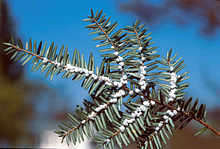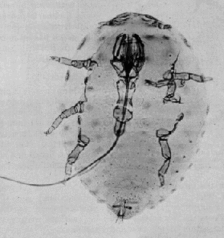Adelgidae: Difference between revisions
m Remove blank line(s) between list items per WP:LISTGAP to fix an accessibility issue for users of screen readers. Do WP:GENFIXES and cleanup if needed. Discuss this at Wikipedia talk:WikiProject Accessibility#LISTGAP |
Rescuing 1 sources and tagging 0 as dead. #IABot (v1.2.4) |
||
| Line 14: | Line 14: | ||
See text |
See text |
||
}} |
}} |
||
The '''Adelgidae''' is a small family of the [[Hemiptera]] closely related to the [[aphid]]s, and often traditionally included in the [[Aphidoidea]] with the Phylloxeridae. Adelgids are often known as "woolly conifer aphids". The family is composed of species associated with [[pine]] [[spruce]] or other conifers, known respectively as "pine aphids" or "spruce aphids". This family includes the former family Chermesidae, or "Chermidae", the name of which was declared invalid by the [[International Commission on Zoological Nomenclature|ICZN]] in 1955.<ref>insects being called "chermes" sometimes. Another name that was common was "dreyfusia" in other locations ([http://www.fs.fed.us/pnw/pubs/pnw_os_rp-18.pdf ''The Balsam Woolly Aphid Problem in Oregon and Washington''], Norman E. Johnson and Kenneth H. Wright, Research paper No. 18, [[United States Forest Service]], [[United States Department of Agriculture]], April, 1957).</ref> There is still considerable debate as to the number of genera within the family, and the classification is still unstable and inconsistent among competing authors.<ref>[http://www.na.fs.fed.us/fhp/hwa/pub/2005_proceedings/wallace.pdf ''A Historical Review of Adelgid Nomenclature''], Matthew S. Wallace, Third Symposium on Woolly Hemlock Adelgids</ref> |
The '''Adelgidae''' is a small family of the [[Hemiptera]] closely related to the [[aphid]]s, and often traditionally included in the [[Aphidoidea]] with the Phylloxeridae. Adelgids are often known as "woolly conifer aphids". The family is composed of species associated with [[pine]] [[spruce]] or other conifers, known respectively as "pine aphids" or "spruce aphids". This family includes the former family Chermesidae, or "Chermidae", the name of which was declared invalid by the [[International Commission on Zoological Nomenclature|ICZN]] in 1955.<ref>insects being called "chermes" sometimes. Another name that was common was "dreyfusia" in other locations ([http://www.fs.fed.us/pnw/pubs/pnw_os_rp-18.pdf ''The Balsam Woolly Aphid Problem in Oregon and Washington''], Norman E. Johnson and Kenneth H. Wright, Research paper No. 18, [[United States Forest Service]], [[United States Department of Agriculture]], April, 1957).</ref> There is still considerable debate as to the number of genera within the family, and the classification is still unstable and inconsistent among competing authors.<ref>[http://www.na.fs.fed.us/fhp/hwa/pub/2005_proceedings/wallace.pdf ''A Historical Review of Adelgid Nomenclature''] {{wayback|url=http://www.na.fs.fed.us/fhp/hwa/pub/2005_proceedings/wallace.pdf |date=20071025222634 }}, Matthew S. Wallace, Third Symposium on Woolly Hemlock Adelgids</ref> |
||
There are about fifty species of adelgids known. All of them are native to the northern hemisphere, although some have been introduced to the southern hemisphere as [[invasive species]].<ref>{{cite web|title=Hemlock Woolly Adelgid|url=http://dontmovefirewood.org/gallery-of-pests/hemlock-woolly-adelgid.html|work=Gallery of Pests|publisher=Don't Move Firewood|accessdate=20 October 2011}}</ref><ref>{{cite web|title=Balsam Woolly Adelgid|url=http://dontmovefirewood.org/gallery-of-pests/balsam-woolly-adelgid.html|work=Gallery of Pests|publisher=Don't Move Firewood|accessdate=20 October 2011}}</ref> Unlike aphids, the adelgids have no tail-like [[Cauda (disambiguation)|cauda]] and no [[cornicle]]s.<ref name=mcgavin>''Bugs of the World'', George C. McGumo, [http://factsonfile.com Facts on File], 1993, ISBN 0-8160-2737-4</ref> |
There are about fifty species of adelgids known. All of them are native to the northern hemisphere, although some have been introduced to the southern hemisphere as [[invasive species]].<ref>{{cite web|title=Hemlock Woolly Adelgid|url=http://dontmovefirewood.org/gallery-of-pests/hemlock-woolly-adelgid.html|work=Gallery of Pests|publisher=Don't Move Firewood|accessdate=20 October 2011}}</ref><ref>{{cite web|title=Balsam Woolly Adelgid|url=http://dontmovefirewood.org/gallery-of-pests/balsam-woolly-adelgid.html|work=Gallery of Pests|publisher=Don't Move Firewood|accessdate=20 October 2011}}</ref> Unlike aphids, the adelgids have no tail-like [[Cauda (disambiguation)|cauda]] and no [[cornicle]]s.<ref name=mcgavin>''Bugs of the World'', George C. McGumo, [http://factsonfile.com Facts on File], 1993, ISBN 0-8160-2737-4</ref> |
||
Revision as of 06:06, 4 October 2016
| Adelgidae | |
|---|---|

| |
| Hemlock woolly adelgid | |
| Scientific classification | |
| Kingdom: | |
| Phylum: | |
| Class: | |
| Order: | |
| Suborder: | |
| Superfamily: | |
| Family: | Adelgidae
|
| Genera | |
|
See text | |
The Adelgidae is a small family of the Hemiptera closely related to the aphids, and often traditionally included in the Aphidoidea with the Phylloxeridae. Adelgids are often known as "woolly conifer aphids". The family is composed of species associated with pine spruce or other conifers, known respectively as "pine aphids" or "spruce aphids". This family includes the former family Chermesidae, or "Chermidae", the name of which was declared invalid by the ICZN in 1955.[1] There is still considerable debate as to the number of genera within the family, and the classification is still unstable and inconsistent among competing authors.[2]
There are about fifty species of adelgids known. All of them are native to the northern hemisphere, although some have been introduced to the southern hemisphere as invasive species.[3][4] Unlike aphids, the adelgids have no tail-like cauda and no cornicles.[5]
Adelgids only lay eggs, and never give birth to live nymphs as aphids do. Adelgids are covered with dense woolly wax. A complete adelgid life cycle lasts two years.[5] Adelgid nymphs are known as sistentes, and the overwintering sistentes are called neosistens.[6]
Rain can kill adelgids by dislodging eggs and sistentes from trees.[7]

Genera
See also
References
- ^ insects being called "chermes" sometimes. Another name that was common was "dreyfusia" in other locations (The Balsam Woolly Aphid Problem in Oregon and Washington, Norman E. Johnson and Kenneth H. Wright, Research paper No. 18, United States Forest Service, United States Department of Agriculture, April, 1957).
- ^ A Historical Review of Adelgid Nomenclature Archived 2007-10-25 at the Wayback Machine, Matthew S. Wallace, Third Symposium on Woolly Hemlock Adelgids
- ^ "Hemlock Woolly Adelgid". Gallery of Pests. Don't Move Firewood. Retrieved 20 October 2011.
- ^ "Balsam Woolly Adelgid". Gallery of Pests. Don't Move Firewood. Retrieved 20 October 2011.
- ^ a b Bugs of the World, George C. McGumo, Facts on File, 1993, ISBN 0-8160-2737-4
- ^ page 724 of Imms' General Textbook of Entomology, Tenth Edition, volume 2, Augustus Daniel Imms, Richard Gareth Davies, Owain Westmacott Richards, Springer, 1977, ISBN 0-412-15220-7
- ^ The Balsam Woolly Aphid Problem in Oregon and Washington, Norman E. Johnson and Kenneth H. Wright, Research paper No. 18, United States Forest Service, United States Department of Agriculture, April, 1957
